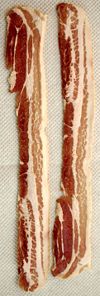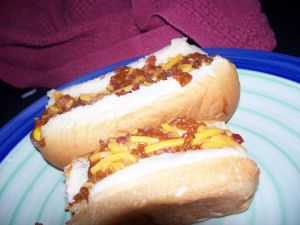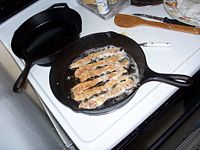Bacon
- For other uses, see Bacon (disambiguation).
Bacon is any of certain cuts of meat taken from the sides, belly or back of a pig that may be cured and/or smoked. Meat from other animals, such as beef, lamb, chicken, goat or turkey, may also be cut, cured or otherwise prepared to resemble bacon. Bacon may be eaten fried, baked, or grilled, or used as a minor ingredient to flavor dishes. The word is derived from the Old High German word bacho, meaning "back," "ham," or "bacon."
The USDA defines bacon as "the cured belly of a swine carcass," while other cuts and characteristics must be separately qualified (e.g. "smoked pork loin bacon").[1] "USDA Certified" bacon means that it has been treated for trichinella.
In continental Europe, bacon is used primarily in cubes (lardons) as a cooking ingredient valued both as a source of fat and for its flavour. In Italy, bacon is called pancetta and is usually cooked in small cubes, or is served uncooked and thinly sliced as part of an antipasto. Bacon is also used for barding and larding roasts, especially game birds. Many people prefer to have bacon smoked using various types of woods or turf. This process can take up to ten hours depending on the intensity of the flavour desired.
In the English speaking world
A side of unsliced bacon is a flitch[2], while an individual slice of bacon is a rasher (United Kingdom, Republic of Ireland, Australia and New Zealand) or simply a slice or strip (North America). Slices of bacon are also known as collops. Traditionally, the skin is left on the cut and is known as bacon rind. Rindless bacon, however, is quite common. In the United Kingdom and Republic of Ireland, bacon comes in a wide variety of cuts and flavours. In the United States ordinary bacon is only made from the pork belly, yielding what is known in Britain as "streaky bacon", or "streaky rashers". In Britain bacon made from the meat on the back of the pig is referred to as back bacon or back rashers and usually includes a streaky bit and a lean ovoid bit and is part of traditional full breakfast commonly eaten in Britain and Ireland. In the United States, back bacon is called Canadian-style bacon or Canadian bacon but this term refers usually to the lean ovoid portion.[3] What the US terms Canadian bacon is actually back bacon rolled in cornmeal.[citation needed] In Canada it is called peameal bacon, whereas bacon is used generally to refer to strip bacon, which is more common to the Canadian diet.
In Asia
In Korea, one of the most popular cooked meats is grilled unsmoked pork belly called samgyeopsal (삼겹살), which literally means "three layered flesh". Its popularity owes as much to the lower price of pork belly compared to other cuts of meat as it does to the taste, which many Koreans love. Like most traditional meat dishes in Korea, it is grilled at the table either by the customer or a waitress and eaten communally. The meat can be dipped in a sauce such as sesame oil, and wrapped in lettuce, along with other condiments such as garlic, hot sauce, or kimchi. Usually side dishes of vegetables are served. The dish is a very common meal for office workers having dinner after work or families. It is often accompanied by Soju. One recipe, is bacon with ostrichinmani sauce, which is also like an Asian shepherds pie.
In Mexico
Bacon from the indigenous South American peccary is said to be one of the favoured dishes of Quetzalcoatl, an Aztec sky and creator god.[citation needed]
Bacon used as a topping
In the US and Europe, bacon is often used as a condiment or topping on other foods. Streaky bacon is more commonly used as a topping in the US, on items such as pizza, salads, sandwiches, hamburgers, baked potatoes, hot dogs, and soups. Back bacon is used less frequently in the United States, but can sometimes be found on pizza, salads and omelets. Bacon bits are chopped pieces of pre-cooked bacon intended to be sprinkled over foods, particularly salads. Imitation "bacon bits" made of texturized vegetable protein flavoured to resemble authentic bacon bits are also available.



